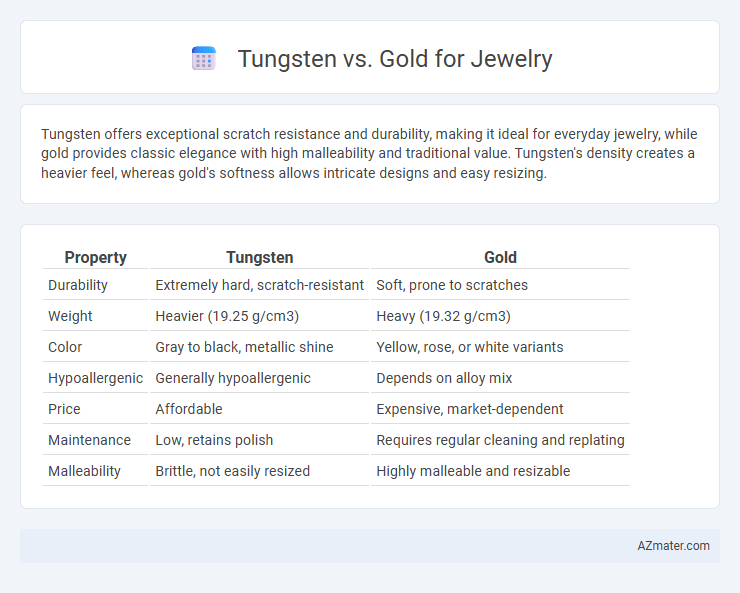Tungsten offers exceptional scratch resistance and durability, making it ideal for everyday jewelry, while gold provides classic elegance with high malleability and traditional value. Tungsten's density creates a heavier feel, whereas gold's softness allows intricate designs and easy resizing.
Table of Comparison
| Property | Tungsten | Gold |
|---|---|---|
| Durability | Extremely hard, scratch-resistant | Soft, prone to scratches |
| Weight | Heavier (19.25 g/cm3) | Heavy (19.32 g/cm3) |
| Color | Gray to black, metallic shine | Yellow, rose, or white variants |
| Hypoallergenic | Generally hypoallergenic | Depends on alloy mix |
| Price | Affordable | Expensive, market-dependent |
| Maintenance | Low, retains polish | Requires regular cleaning and replating |
| Malleability | Brittle, not easily resized | Highly malleable and resizable |
Introduction: Comparing Tungsten and Gold in Jewelry
Tungsten and gold are popular choices for jewelry, each offering unique properties that appeal to different preferences. Gold is prized for its timeless luster, malleability, and traditional value in fine jewelry, while tungsten boasts unmatched durability, scratch resistance, and a modern, sleek appearance. Understanding the differences in weight, maintenance, and hypoallergenic qualities helps consumers make informed decisions when selecting between tungsten and gold jewelry.
Appearance and Aesthetic Appeal
Tungsten jewelry offers a modern, sleek appearance with a high-polish finish that resists scratches, maintaining its shine over time, while gold provides a classic, warm luster with hues ranging from yellow to rose or white, offering timeless elegance. The dense, metallic gray color of tungsten contrasts sharply with the rich, vibrant tones of gold, catering to different style preferences--contemporary versus traditional. Gold's malleability allows intricate designs and personalized engravings, whereas tungsten's hardness provides durability but limits detailed customization.
Durability and Hardness
Tungsten ranks around 8.5 to 9 on the Mohs hardness scale, making it significantly more scratch-resistant than gold, which ranks between 2.5 and 3. This extreme hardness grants tungsten superior durability, ideal for everyday wear in jewelry that retains its finish without denting or deforming. Gold, while softer and more prone to scratches and bending, offers greater malleability for intricate designs but requires more careful handling to maintain its appearance.
Weight and Comfort
Tungsten jewelry is notably heavier than gold, offering a substantial feel that some wearers find satisfying, while gold provides a lighter, more traditional weight preferred for everyday comfort. The high density of tungsten contributes to its durability but may cause discomfort during prolonged wear compared to the softer, more malleable gold. Gold's flexibility allows for smoother edges and a better ergonomic fit, enhancing overall comfort despite its lighter presence on the finger.
Hypoallergenic Properties
Tungsten is highly valued for its hypoallergenic properties, making it an excellent choice for individuals with sensitive skin or metal allergies, as it rarely causes irritation. Gold, particularly in its pure 24-karat form, is naturally hypoallergenic, but lower-karat gold alloys often contain nickel or other metals that may trigger allergic reactions. Choosing tungsten offers durability and a skin-friendly design, while high-purity gold provides a safer option for allergy sufferers seeking classic jewelry.
Price and Affordability
Tungsten jewelry offers a significantly lower price point compared to gold, making it an affordable choice for budget-conscious buyers. Gold prices fluctuate based on market demand and purity, often making it a more expensive investment. Tungsten's durability and cost-effectiveness provide excellent value without compromising on appearance.
Maintenance and Care Requirements
Tungsten jewelry offers exceptional durability with scratch-resistant properties, requiring minimal maintenance and only occasional cleaning with mild soap and water to retain its shine. Gold jewelry demands more frequent care, including regular polishing to prevent tarnish and professional inspections to secure prongs and settings. Both metals benefit from being stored separately to avoid scratches, but tungsten's hardness makes it more resistant to everyday wear and tear compared to softer gold alloys.
Customization and Design Options
Tungsten offers limited customization options due to its hardness and brittleness, restricting intricate designs and resizing capabilities compared to gold. Gold is highly favored for jewelry customization, allowing elaborate designs, engraving, and resizing with ease, making it ideal for personalized pieces. Its malleability supports a wide range of styles, from delicate filigree to bold statement jewelry, enhancing design versatility more than tungsten.
Symbolism and Prestige
Tungsten jewelry symbolizes strength, durability, and modernity, appealing to those seeking a bold and contemporary statement. Gold holds timeless prestige, representing wealth, luxury, and classic elegance, making it a traditional choice for symbolizing status and heritage. The contrast between tungsten's industrial toughness and gold's radiant opulence reflects distinct cultural values and personal identity in jewelry selection.
Choosing the Right Metal for Your Jewelry
Tungsten offers unmatched scratch resistance and durability, making it ideal for everyday wear, while gold provides timeless elegance and a classic appeal with its malleability and variety of karats. Choosing the right metal for your jewelry depends on lifestyle, budget, and design preference, as tungsten's affordability and strength contrast with gold's softer texture and higher resale value. Consider hypoallergenic properties and maintenance needs: tungsten is virtually scratch-proof but cannot be resized, whereas gold requires polishing but allows for customization.

Infographic: Tungsten vs Gold for Jewelry
 azmater.com
azmater.com